Dometic RM 4605, RM 2455, RM 2355, RM 2555 User Manual

RA/RM-1D
RA/RM-2D
AES III
RM 2355
RM 2455
RM 2555
RM 4605
825 12 40-02

OPERATING AND INSTALLATION INSTRUCTIONS FOR RM 2355, RM 2455, RM 2555 & RM 4605
NTRODUCTION
We are pleased that you have chosen this refrigerator and hope you will derive much satisfaction from using it.
The refrigerator is designed for installation in motorhomes and intended for storage of foods, frozen foods and making ice. It comes with Automatic Energy Selector (AES) which controls operation and energy supply. To put the refrigerator in operation, just trip the main switch - AES manages the rest.
Read this manual very carefully before using the refrigerator. Make sure to retain it for future reference. In this manual you will fi nd information on how to install, operate and maintain your new appliance. To ensure good refrigeration and economical operation, the refrigerator has to be installed and used as described in these instructions.
The installation must be performed by an authorised person and in accordance with the manufacturers installation instructions, local gas fi tting regulations, municipal building codes, electrical wiring regulations, AS5601 “Gas Installations” and any other statutory regulations.
TRANSIT DAMAGE
Before you install your refrigerator, ensure to remove all protective packaging. Check for any damage or marks. Transit damage must be reported to whoever is responsible for delivery not later than seven days after the refrigerator was delivered.
DATA PLATE
Check the data plate, inside the refrigerator, to ensure that you have received the right model.
Below you can make a note of the details stated on the data plate. It is a good idea to this since this information is needed if you have to contact service personnel. The data plate contains e. g. the following details:
Model designation RM
Product number |
|
Serial number |
|
Voltage |
230 - 240 volts |
Gas pressure |
2,70 kPa |
CONTENTS
OPERATING INSTRUCTIONS |
4 |
CONTROL PANEL |
4 |
AES |
4 |
STARTING THE REFRIGERATOR |
4 |
LP GAS OPERATION |
4 |
230-240V OPERATION |
4 |
12V OPERATION |
4 |
SWITCHING BETWEEN ENERGY SOURCES |
5 |
REGULATING THE TEMPERATURE |
5 |
TRAVEL CATCH |
5 |
USING THE REFRIGERATOR |
5 |
DEFROSTING |
5 |
CLEANING THE REFRIGERATOR |
6 |
REPLACING THE BULB |
6 |
HEATING CABLE |
6 |
TURNING OFF THE REFRIGERATOR |
6 |
PRODUCT CARE - SOME USEFUL HINTS |
6 |
TROUBLESHOOTING |
6 |
MAINTENANCE |
7 |
SERVICE AND SPARE PARTS |
7 |
NSTALLATION INSTRUCTIONS |
7 |
VENTILATION OF THE UNIT |
7 |
CONNECTING POINTS |
9 |
NSTALLATION/BUILDING-IN |
|
SECURING THE REFRIGERATOR |
|
DRAIN WATER HOSE |
2 |
CONNECTIONS |
2 |
MOUNTING INSTRUCTIONS |
3 |
TECHNICAL DATA |
6 |
REARVIEW EQUIPMENT |
7 |
WIRING DIAGRAM |
8 |
WORKING INSTRUCTIONS FOR |
9 |
THE GAS SAFETY SYSTEM |
|
APPENDIX A - AIRING POSITION CARD |
20 |
3
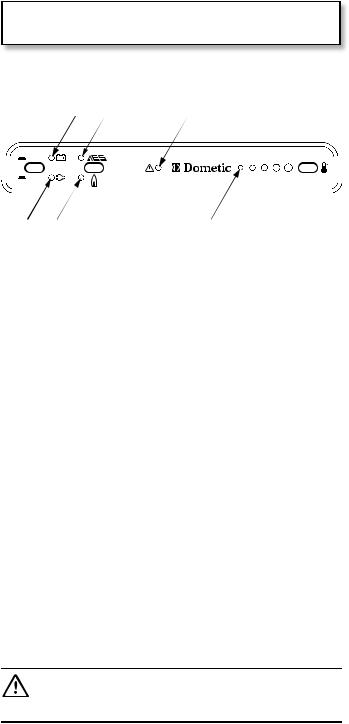
CONTROL PANEL
|
D A |
F |
|
ON |
|
|
3 C |
1 |
2 |
|
|
OFF |
|
|
|
C |
B |
E |
Fig. 1 |
1.ON/OFF button (main power button)
2.AES/GAS mode selector button
3.Temperature selector button
A.AES mode indicator lamp
B.GAS mode indicator lamp
C.AC mode indicator lamp
D.DC mode indicator lamp
E.Temperature indicator lamp
F.Warning indicator lamp (gas failure)
AES
The refrigerator is equipped with an Automatic Energy Selector (AES) controlling the operation and energy supply.
NOTE! 12V must always be available to supply the electronics.
The system selects the available energy source in the order:
1.230-240V
2.12V
LP GAS OPERATION
AES will select LP gas operation under the following conditions:
No AC (230-240V) available
Engine not running (no high current at 12V DC available)
When the system chooses LP gas operation, the fl ame failure device is automatically opened, allowing the gas to fl ow to the burner. At the same time, the electronic igniter is energized.
After initial installation, servicing, or changing gas cylinders etc., the gas pipes may contain some air that should be allowed to escape by briefl y turning on the refrigerator or other appliances. This will ensure that the fl ame lights immediately.
If the fl ame goes out (by gust of wind etc.), the reigniter will automatically relight the fl ame.
NOTE! The control electronics and the igniter must have 12V DC (battery) supply to operate.
GAS TROUBLESHOOTING
If the Warning indicator lamp (F) is lit, there has been a failure of gas operation. To troubleshoot, follow these steps:
1.Turn off the refrigerator. (Press the ON/OFF (1) to “OFF”.)
2.Check that there is enough gas in the gas bottle, that its valve is open and that any valves in the gas line to the refrigerator are open.
3.Turn on the refrigerator again. (Press the ON/OFF button (1) to “ON” .) After 10 sec. AES will repeat the ignition
equence.
4.Should the warning lamp come on again after approx. 6 minutes, the failure is still present. Repeat the procedure more. If this does not help, contact an authorised
service provider in your area.
3.LP gas
Turn off the AES function if you want the refrigerator to run on LP gas only.
STARTING THE REFRIGERATOR
Whilst mobile:
Do not operate the refrigerator on LP gas.
Turn off the gas bottle.
1.Press the ON/OFF button (1). The refrigerator starts in the mode it was in when it was turned off.
2.Press the AES/GAS button (2) and LED (A) or (B) comes on. Select AES or LP gas only by pressing the AES/GAS button (2) once if necessary.
3.If a 230V-240V mains supply is available:
AES selects this as the energy source and LEDs (A) and
(C) come on.
When the vehicle’s engine is running, AES selects 12V operation and LEDs (A) and (D) are illuminated unless LP gas only operation has been selected manually.
If neither mains nor a 12V battery supply are available: AES selects LP gas operation and LEDS (A) and (B)
ome on.
LP gas-only operation can be selected by pressing the AES/ GAS button (2) until LED (B) comes on; the AES function is then turned off and LED (A) goes out. The Temperature selector button (3) is used to set the electronic thermostat. The LEDs (E) show the value set on the thermostat.
ABNORMAL OPERATION
Any of the following are considered to be abnormal operation and may require servicing:
Yellow tipping of the burner fl ame.
Sooting up area surrounding burner.
Burner not igniting properly.
Burner failing to remain alight.
In case the appliance fails to operate correctly, contact an authorised Dometic Service Centre.
230-240V OPERATION
When a mains connection is available, AES will select this. Please note, that even being in AC mode, 12V DC is necessary for the internal supply of the electronics.
12V OPERATION
AES will select the 12V mode of operation as soon as the vehicle engine is running (detected by the alternator connection of the fridge D+).
If the 12V DC goes down below 9V DC, the system will shut down completely.
4
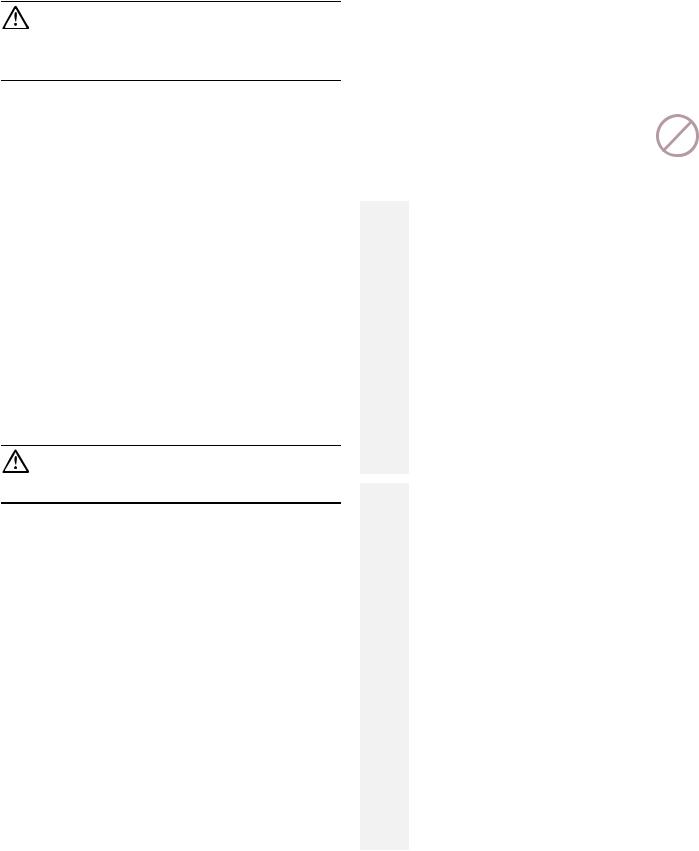
SWITCHING BETWEEN ENERGY SOURCES
When switching from one energy source to another, there are some delays implemented in the AES system. The 15 min. delay between switching off the engine and starting gas mode is intended to delay the starting of gas mode e.g. when stopping at a fi lling station.
WARNING! It is not allowed to have a naked
fl ame at a gas fi lling station. If you are not sure, that your stop is shorter than 15 min., you are advised to set the ON/OFF switch (1) to “OFF”, when stopping at a fi lling station.
REGULATING THE TEMPERATURE
The position number refers to Fig.1.
It will take a few hours for the refrigerator to reach normal operating temperature. So we suggest you start it well in advance of a trip and if possible store it with precooled foodstuffs.
The temperature of the refrigerator main compartment is set for all three sources of energy, by means of the Temperature selector button (3). After turning on the refrigerator the system automatically chooses the mid-position. With some experience you will soon fi nd a suitable setting, bigger circles indicate lower temperatures. This normally does not need resetting because the same thermostat controls the main compartment temperature for any of the three sources of energy.
TRAVEL CATCH
Make sure that the travel catch is engaged when the motorhome is on the move.
USING THE REFRIGERATOR
WARNING! DO NOT store explosive substances in the refrigerator, such as cigarette lighter gas, gasoline, ether or the like.
FOOD STORAGE
Always keep food in closed containers. Never put hot food in the refrigerator; allow it to cool fi rst.
The frozen food compartment is intended for the storage of frozen food and for making ice. Most kinds of frozen food can be stored in the frozen food compartment for about a month. This period of time may vary, however, and it is important to follow the instructions on the individual packages.
CE MAKING
Fill the ice tray to just below the brim with drinking water and place them on the bottom of the freezer compartment. Ice will be made more rapidly if the thermostat is set at its highest position (biggest circle), but be sure to move the thermostat back to normal setting when the ice is formed; the refrigerator might otherwise become too cold.
DEFROSTING
Frost will gradually accumulate on the refrigerating surfaces. Each time the door is opened some of the cold air in the refrigerator spills out and is replaced by warm moist room air. As this air is cooled, the moisture is deposited onto the evaporator coils or other cold surfaces inside the refrigerator and can cause frost build-up. It is important that you do not leave the unit’s door open any longer than necessary. This will reduce frost formation and increase the effi ciency of your refrigerator. The frost must not be allowed to grow too thick as it acts as an insulator and adversely affects refrigerator performance. Check the formation of frost regularly every week and when it gets about 3 mm thick, defrost the refrigerator.
Do not try to accelerate defrosting by using any kind of heating appliance, as this might damage the plastic surfaces of the refrigerator. Neither should any sharp objects be used to scrape off the ice.
|
To defrost the refrigerator, follow these steps: |
|
|
1. |
Turn off the refrigerator. (Press the ON/OFF |
|
|
button (1) to ”OFF”.) |
|
2. |
Empty the refrigerator. (Remove ice trays |
|
|
and food.) |
RM 2355 |
3. |
Leave the drip tray under the fi nned evapo- |
|
rator |
|
RM 2455 |
4. |
Leave the cabinet and freezer door open. |
|
|
|
RM 2555 |
Defrost water runs from the drip tray through |
|
a plastic drain water hose to the outside of the |
||
|
vehicle. When all the frost has melted - dry the |
|
|
interior of the refrigerator with a clean cloth and |
|
|
replace ice trays and food. Set the thermostat to |
|
|
the coldest position for a few hours. Then, reset |
|
|
the thermostat to the desired setting, usually at |
|
|
mid setting. |
|
|
To defrost the refrigerator, follow these steps: |
|
|
1. |
Turn off the refrigerator. (Press the ON/OFF |
|
|
button (1) to ”OFF”.) |
|
2. |
Empty the refrigerator. (Remove ice trays |
|
|
and food.) |
|
3. |
Leave the cabinet and freezer door open. |
|
Defrost water runs from a collector channel to a |
|
|
receptacle at the rear of the refrigerator where it |
|
RM 4605 |
normally evaporates. With a lot of defrost water, |
|
as a result of heavy frost build-up on the freezer |
||
|
plate and the cooling fi ns, move the plastic drain |
|
tube in to a watertight bucket or container. (Access through the lower ventilation grill on the outside of the vehicle). As the frost melts, the water will fl ow into the container. Replace the drain tube to its original position after defrosting. Defrost water in the freezer compartment should be mopped up with a cloth.
When the ice has melted - wipe the refrigerator dry, restart it and then, place the food items back inside but wait until the refrigerator is cold before making ice cubes.
5
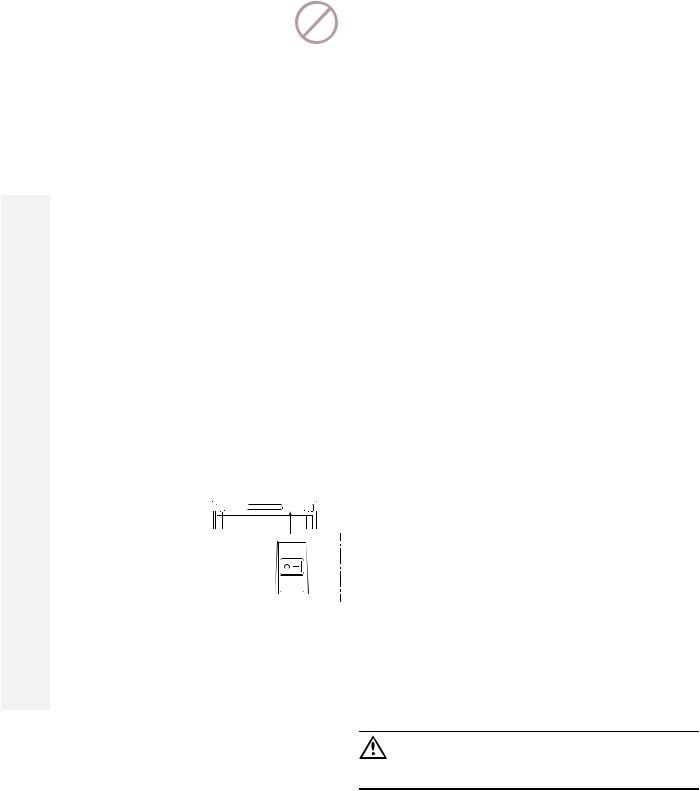
CLEANING THE REFRIGERATOR
Clean the inside of the refrigerator regularly to keep it fresh and hygienic.
Soak a cloth in a solution consisting of a teaspoon of bicarbonate of soda to half a litre of warm water. Wring out the cloth and use it to clean the interior of the refrigerator and its fi ttings.
Never use detergents, scouring powder, strongly scented products or wax polish to clean the interior of the refrigerator as they may damage the surfaces and leave a strong odour.
The exterior of the refrigerator should be wiped clean now and then, using a damp cloth and a small quantity of detergent. But not the door gasket, which should only be cleaned with soap and water and then thoroughly dried.
The cooling unit behind the refrigerator should be cleaned with a brush from time to time, but make sure that the refrigerator is switched off when doing this.
REPLACING THE BULB
To replace the bulb, follow these steps:
1.Remove the cover from the lamp body by pushing it backwards.
2.Remove the bulb.
3.Put in a new bulb (12V, max. 10 W).
4.Push the lamp cover back in place.
HEATING CABLE
During the summer months of high temperatures and humidity, the metal frame between the freezer and fresh food compartments may have
water droplets forming. This refrigerator comes RM 4605 standard with a 12V DC heating cable that will
evaporate the water droplets when they form.
To have the heating cable on, you position the switch located beneath the control panel to I, see Fig. 2.
The heating cable can |
|
|
|
be left on continuously |
OFF |
CONTROL |
ON |
|
|
CLIMATE- |
|
or only used when tem- |
|
SWITCH |
|
|
|
|
|
peratures require it. |
|
|
|
Fig. 2
NOTE! The heating cable will draw 12V DC power continuously when in the ON (I) position. It should be turned off when a charging source is not available.
TURNING OFF THE REFRIGERATOR
If the refrigerator is not to be used for some time:
1.Turn off the refrigerator. (Press the ON/OFF button (1) to “OFF”.)
2.Shut off any on-board valve in the gas line to the refrigerator.
3.Pull out the plug from the wall socket.
4.Empty the refrigerator. Defrost and clean it as described earlier. Leave the doors of the refrigerator and frozen food compartment ajar.
PRODUCT CARE - SOME USEFUL HINTS
Make sure that:
Defrosting is carried out periodically.
The refrigerator is clean and dry with the door left open when it is not to be used for some time.
Liquids or items with a strong odour are well packed.
The ventilation openings are unobstructed.
The doors are secured by means of the travel catch when the motorhome is on the move.
TROUBLESHOOTING
F THE REFRIGERATOR FAILS TO WORK
Before calling an authorised service technician:
Ensure that the instructions in this manual have been followed.
Check to make sure that the refrigerator is not tilted excessiveley.
Verify that the LEDs on the control panel are lit when the ON/OFF button (1) is turned on. (12V must be available.)
Check that the 12V fuse is intact.
NOTE! Before servicing and when checking the fuses - disconnect the wall plug and the 12V wires.
Check the fuses on the circuit board which is located under the cover on the back of the refrigerator.
If the mains voltage are connected but the refrigerator stays in gas operation -> is the refrigerator correctly connected and is the fuse (230-240V) intact?
If the refrigerator does not operate in DC mode when the engine is running -> is the alternator (D+) connection made correctly?
If the Warning indicator lamp (F) lights up -> see ”GAS TROUBLESHOOTING” for further information.
THE REFRIGERATOR IS NOT COLD ENOUGH
If the refrigerator is not cold enough it may be because:
The ventilation is inadequate owing to reduced area of the ventilation passages (partial blockage of grilles from wire mesh etc.).
The evaporator is frosted up.
The temperature control setting is incorrect.
The gas pressure is incorrect - check the pressure regulator at the gas container.
The ambient temperature is too high.
Too much food is loaded at one time.
The door is not properly closed or the magnetic sealing strip is defective.
If the refrigerator still does not work properly, call an authorised service technician.
WARNING! The sealed cooling system must not be opened, since it contains corroding chemicals under high pressure.
6
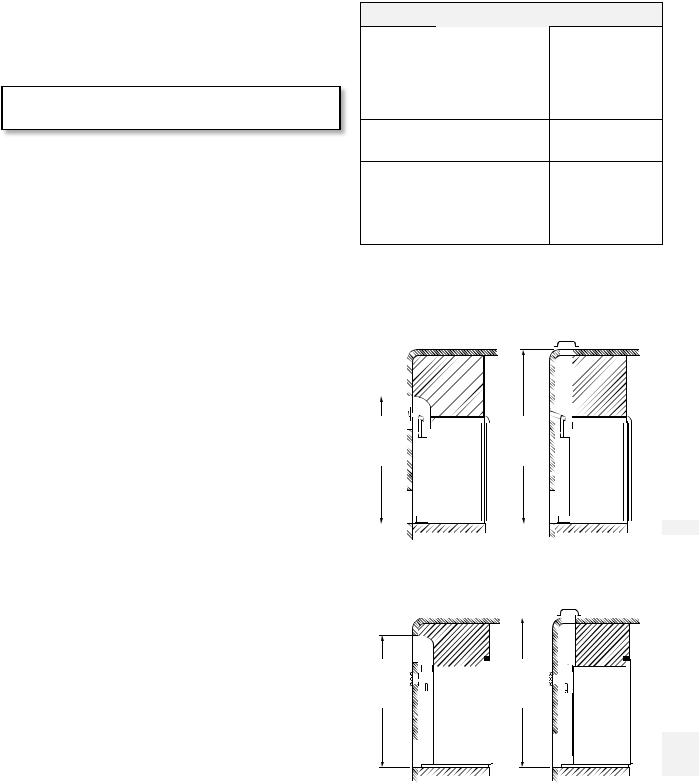
MAINTENANCE
This appliance must be serviced by an authorised person. We recommend that an authorised service technician checks the refrigerator once a year.
The “Installation and operating instructions manual” should always be available.
Ensure that the gas safety shut-off valve is working properly.
Make sure that the ventilation openings are unobstructed.
See to it that the burner is clean and free from combustible material.
All connections in the LP gas system should be checked for gas leaks. Connections can be tested for leaks using a soap solution. DO NOT use a naked fl ame! If there is any suspicion of damage, call for an authorised service technician.
SERVICE AND SPARE PARTS
Service and spare parts are obtainable from your dealer or Dometic - consult the telephone directory.
The refrigerator is intended for installation in a motorhome, and the information relates to this application. A correct installation is important for correct operation of the appliance. The refrigerator must be installed on a solid fl oor and must be level. With the vehicle carefully levelled, the refrigerator should be level both ways in the freezer compartment. Free air circulation over the fi ns of the cooling unit is essential.
VENTILATION OF THE UNIT
VENTILATION GRILLES
We recommend fi tting the Dometic ventilation system, which is specially developed by Dometic for this purpose. The Dometic ventilation grilles permit inspection and small repairs to be carried out without the necessity of removing the refrigerator from the recess.
If there is no outer grille at fl oor level where leaking gas can escape, a 40 mm hole to the outside should be made in the
fl oor of the recess to drain any unburned gas to the outside. Fit the hole with wire mesh and an angled plate to protect it from stones, mud etc.
SIDE VENTILATION
The refrigerator unit is ventilated via two openings in the wall of the motorhome. Fresh air enters through the lower opening and warm air is discharged through the upper one.
The lower opening should be located at fl oor level (to allow any leaking gas to escape to the outside). The upper ventilation opening should be located above the condenser, as high as possible, to ensure good ventilation. We recommend the ventilation kit A1625.
ROOF VENTILATION
The ventilation of the cooling unit can also be done via one opening in the wall of the motorhome and one on the roof for the roof vent.
Fresh air enters through the lower opening and warm air is discharged through the roof vent. The lower opening should be located at fl oor level (to allow any leaking gas to escape to the outside). We recommend the ventilation kit A1625 together with the roof vent R500.
REMOVAL OF FLUE GASES
The ventilation passage at the rear of the recess, between the outer wall of the vehicle and the refrigerator must be sealed off against the living space, so cold draughts are excluded (winter camping) and no fl ue gases can penetrate into the motorhome
The fl ue gases are dispersed from the ventilation passage using the Dometic fl ueing system. The top, bottom and sides of the ventilation passage should be insulated to prevent condensation and cold draughts. The ventillation passage walls must be constructed of a non combustable material.
VENTILATION HEIGHTS
Minimum ventilation heights (mm)
|
Installation with |
Installation with |
|
|
upper and lower |
roof vent and |
|
|
side vent |
lower side vent |
|
RM 2355 |
864 |
787 |
|
(Fig. 3) |
|||
|
|
||
RM 2455 |
960 |
960 |
|
(Fig. 4) |
|||
|
|
||
RM 2555 |
1130 |
1130 |
|
(Fig. 4) |
|||
|
|
||
RM 4605 |
1760 |
1465 |
|
(Fig. 4) |
|||
|
|
NOTE! At extreme ambient temperatures the refrigeration unit will only perform adequately when properly ventilated.



Fig. 3
RM 2355




Fig. 4
RM 2455
RM 2555
RM 4605
7
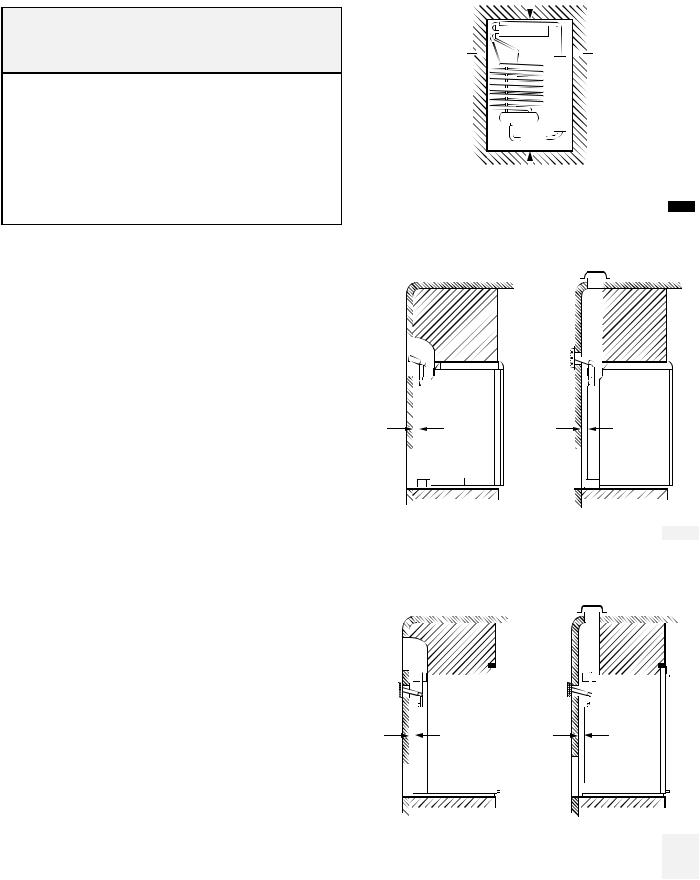
CLEARANCES
Minimum clearances (mm) to combustible materials are:
|
|
RM 2355 RM 2455 - RM 2555 - RM 4605 |
|
|
|
(Fig. 5 & |
(Fig. 5 & |
|
|
Fig. 6) |
Fig. 7) |
G |
Top |
0 |
0 |
K |
Side |
0 |
0 |
L |
Bottom |
0 |
0 |
M |
Rear |
25 |
0 |
1The distance between the rearmost part of the refrigerator and the wall behind the refrigerator.
G
K 
 K
K
L
MM
Fig. 6
RM 2355
MM
Fig. 7
RM 2455
RM 2555
RM 4605
8
